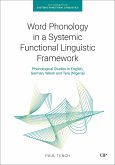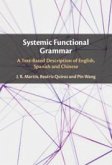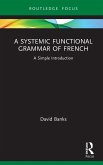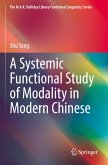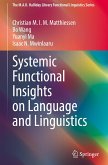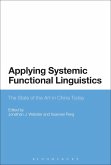Christian Matthiessen
Systemic Functional Linguistics, Part 2
Herausgeber: Teruya, Kazuhiro; Slade, Diana; Peijia, Kaela
Christian Matthiessen
Systemic Functional Linguistics, Part 2
Herausgeber: Teruya, Kazuhiro; Slade, Diana; Peijia, Kaela
- Gebundenes Buch
- Merkliste
- Auf die Merkliste
- Bewerten Bewerten
- Teilen
- Produkt teilen
- Produkterinnerung
- Produkterinnerung
The second volume of this definitive text expands upon Christian M.I.M. Matthiessen’s work on Systemic Functional Linguistics spanning forty years, offering a fundamental understanding of his theories.
Andere Kunden interessierten sich auch für
![Word Phonology in a Systemic Functional Linguistic Framework Word Phonology in a Systemic Functional Linguistic Framework]() Paul TenchWord Phonology in a Systemic Functional Linguistic Framework93,99 €
Paul TenchWord Phonology in a Systemic Functional Linguistic Framework93,99 €![Systemic Functional Grammar Systemic Functional Grammar]() J R MartinSystemic Functional Grammar138,99 €
J R MartinSystemic Functional Grammar138,99 €![A Systemic Functional Grammar of French A Systemic Functional Grammar of French]() David BanksA Systemic Functional Grammar of French74,99 €
David BanksA Systemic Functional Grammar of French74,99 €![Key Terms in Systemic Functional Linguistics Key Terms in Systemic Functional Linguistics]() Christian MatthiessenKey Terms in Systemic Functional Linguistics37,99 €
Christian MatthiessenKey Terms in Systemic Functional Linguistics37,99 €![A Systemic Functional Study of Modality in Modern Chinese A Systemic Functional Study of Modality in Modern Chinese]() Shu YangA Systemic Functional Study of Modality in Modern Chinese91,99 €
Shu YangA Systemic Functional Study of Modality in Modern Chinese91,99 €![Systemic Functional Insights on Language and Linguistics Systemic Functional Insights on Language and Linguistics]() Christian M.I.M. MatthiessenSystemic Functional Insights on Language and Linguistics91,99 €
Christian M.I.M. MatthiessenSystemic Functional Insights on Language and Linguistics91,99 €![Applying Systemic Functional Linguistics Applying Systemic Functional Linguistics]() Applying Systemic Functional Linguistics143,99 €
Applying Systemic Functional Linguistics143,99 €-
-
-
The second volume of this definitive text expands upon Christian M.I.M. Matthiessen’s work on Systemic Functional Linguistics spanning forty years, offering a fundamental understanding of his theories.
Produktdetails
- Produktdetails
- Verlag: University of Toronto Press
- Seitenzahl: 528
- Erscheinungstermin: 1. Januar 2021
- Englisch
- Abmessung: 229mm x 127mm x 13mm
- Gewicht: 499g
- ISBN-13: 9781487503222
- ISBN-10: 1487503229
- Artikelnr.: 74005346
- Herstellerkennzeichnung
- Libri GmbH
- Europaallee 1
- 36244 Bad Hersfeld
- gpsr@libri.de
- Verlag: University of Toronto Press
- Seitenzahl: 528
- Erscheinungstermin: 1. Januar 2021
- Englisch
- Abmessung: 229mm x 127mm x 13mm
- Gewicht: 499g
- ISBN-13: 9781487503222
- ISBN-10: 1487503229
- Artikelnr.: 74005346
- Herstellerkennzeichnung
- Libri GmbH
- Europaallee 1
- 36244 Bad Hersfeld
- gpsr@libri.de
Christian M.I.M. Matthiessen is a distinguished professor in the Department of Linguistics at the University of International Business and Economics, as well as distinguished professor of linguistics at Hunan University, guest professor at Beijing Science and Technology University, and honorary professor at the Australian National University. Kazuhiro Teruya is an associate professor in the Department of Chinese and Bilingual Studies at Hang Seng University of Hong Kong. Kaela Peijia Zhang is a lecturer in the Department of English at Hang Seng University of Hong Kong. Diana Slade is a professor of applied linguistics and director of the Institute for Communication in Health Care at the Australian National University.
Foreword
David Butt
Editorial Introduction
Kazuhiro Teruya, Kaela Peijia Zhang, and Diana Slade
Introduction
Christian M.I.M. Matthiessen
1. A Grammar and a Lexicon for a Text-Production System
2. Systemic Grammar in Computation: The NIGEL Case
3. Semantics for a Systemic Grammar: The Chooser and Inquiry Framework
4. Two Approaches to Semantic Interfaces in Text Generation
5. Metafunctional Complementarity and Resonance in Syntagmatic Organization
6. Fuzziness Construed in Language: A Linguistic Perspective
7. On the Idea of Theory-Neutral Descriptions
8. Interview with Christian Matthiessen (Cardiff, 1998)
9. Halliday’s Conception of Language as a Probabilistic System
10. Instantial Systems and Logogenesis
11. Systemic Functional Morphology: The Lexicogrammar of the Word
12. The Architecture of Language According to SFL: Some Reflections on
Implications for Neurosemiotics
David Butt
Editorial Introduction
Kazuhiro Teruya, Kaela Peijia Zhang, and Diana Slade
Introduction
Christian M.I.M. Matthiessen
1. A Grammar and a Lexicon for a Text-Production System
2. Systemic Grammar in Computation: The NIGEL Case
3. Semantics for a Systemic Grammar: The Chooser and Inquiry Framework
4. Two Approaches to Semantic Interfaces in Text Generation
5. Metafunctional Complementarity and Resonance in Syntagmatic Organization
6. Fuzziness Construed in Language: A Linguistic Perspective
7. On the Idea of Theory-Neutral Descriptions
8. Interview with Christian Matthiessen (Cardiff, 1998)
9. Halliday’s Conception of Language as a Probabilistic System
10. Instantial Systems and Logogenesis
11. Systemic Functional Morphology: The Lexicogrammar of the Word
12. The Architecture of Language According to SFL: Some Reflections on
Implications for Neurosemiotics
Foreword
David Butt
Editorial Introduction
Kazuhiro Teruya, Kaela Peijia Zhang, and Diana Slade
Introduction
Christian M.I.M. Matthiessen
1. A Grammar and a Lexicon for a Text-Production System
2. Systemic Grammar in Computation: The NIGEL Case
3. Semantics for a Systemic Grammar: The Chooser and Inquiry Framework
4. Two Approaches to Semantic Interfaces in Text Generation
5. Metafunctional Complementarity and Resonance in Syntagmatic Organization
6. Fuzziness Construed in Language: A Linguistic Perspective
7. On the Idea of Theory-Neutral Descriptions
8. Interview with Christian Matthiessen (Cardiff, 1998)
9. Halliday’s Conception of Language as a Probabilistic System
10. Instantial Systems and Logogenesis
11. Systemic Functional Morphology: The Lexicogrammar of the Word
12. The Architecture of Language According to SFL: Some Reflections on
Implications for Neurosemiotics
David Butt
Editorial Introduction
Kazuhiro Teruya, Kaela Peijia Zhang, and Diana Slade
Introduction
Christian M.I.M. Matthiessen
1. A Grammar and a Lexicon for a Text-Production System
2. Systemic Grammar in Computation: The NIGEL Case
3. Semantics for a Systemic Grammar: The Chooser and Inquiry Framework
4. Two Approaches to Semantic Interfaces in Text Generation
5. Metafunctional Complementarity and Resonance in Syntagmatic Organization
6. Fuzziness Construed in Language: A Linguistic Perspective
7. On the Idea of Theory-Neutral Descriptions
8. Interview with Christian Matthiessen (Cardiff, 1998)
9. Halliday’s Conception of Language as a Probabilistic System
10. Instantial Systems and Logogenesis
11. Systemic Functional Morphology: The Lexicogrammar of the Word
12. The Architecture of Language According to SFL: Some Reflections on
Implications for Neurosemiotics


